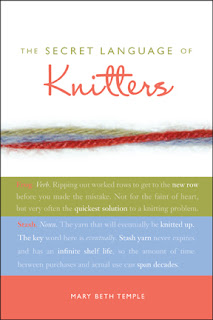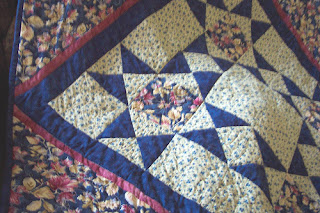 My blog entries have been pretty mild as far as 'subversive stitchers' go. But let me raise the bar a bit with the lovely Karen McTavish of Duluth, Minnesota, who has a quilting technique named after her. Ever heard of McTavishing?
My blog entries have been pretty mild as far as 'subversive stitchers' go. But let me raise the bar a bit with the lovely Karen McTavish of Duluth, Minnesota, who has a quilting technique named after her. Ever heard of McTavishing?If you are into machine quilting, Karen and McTavishing are part of your experience. She invented the curling, waving form of machine filler stitch based upon the image of 'cartoon hair' -- don't think Betty Boop, think Brenda Starr with hair whipp
 ing out and curling around her fair face. Now take away the face and you have an idea of the origins of McTavishing. It doesn't just fill the space but gives the quilt a sense of movement as your gaze glides across its surface. It can be used in place of stippling or meandering designs. And looks beautiful on appliqued, pieced or wholecloth quilts, especially in conjunction with trapunto. Karen's gallery gives you superb examples of not only her skill, but of exquisite quilts.
ing out and curling around her fair face. Now take away the face and you have an idea of the origins of McTavishing. It doesn't just fill the space but gives the quilt a sense of movement as your gaze glides across its surface. It can be used in place of stippling or meandering designs. And looks beautiful on appliqued, pieced or wholecloth quilts, especially in conjunction with trapunto. Karen's gallery gives you superb examples of not only her skill, but of exquisite quilts.Karen is making waves, garnering awards, and teaching others her techniques. She is causing movement within the quilt world with her innovative techniques and approach to quilting, raising it to an art form.
She has changed the image of quilters forever. Mention 'quilter' to the average guy on the street and he quickly envisioned white haired old lady with bun and Amish heritage. She wears an apron and cap, gathers around quilting frames with others of her kind and they discuss recipes and child raising while sticking little needles in and out and in and out of fabric. Even my own vision of 'quilter' turns more toward the image of Mom or Grandma. But one refreshing view of Karen and you'll never think of quilter quite the same. She is the biker chick with laughing eyes of quilting, and her 'needle' is the Harley Davidson of the quilting world.
 She and her long-arm machine eat up the miles, travel down roads others have never traveled and feel the wind in her hair.... Well, you get the picture. One other thing you need to envision when thinking Karen McTavish: tattoos.
She and her long-arm machine eat up the miles, travel down roads others have never traveled and feel the wind in her hair.... Well, you get the picture. One other thing you need to envision when thinking Karen McTavish: tattoos.She translates her quilt designs into skin art. Now that's my idea of a subversive stitcher.
If you want to learn more about Karen's techniques with cloth, not skin, she has a new book out: Quilting for Show: A Practical Guide to Successful Competition Quilting is available. She has written several books. But it was her trivia game for quilters that caught my attention! Sew You Want to be a Quilter has a game board and uses colored spools of thread as game pieces. It comes with 500 cards filled with questions about what else, quilting! The players must travel to four quilting shops before they can win and all start out together at the gazebo. Answer questions correctly and advance the number of spaces decided by a throw of the dice. Informative and fun and something to do when not working on quilts. Or a great way to educate your family into the world of quilting. I want one! I want one!







































